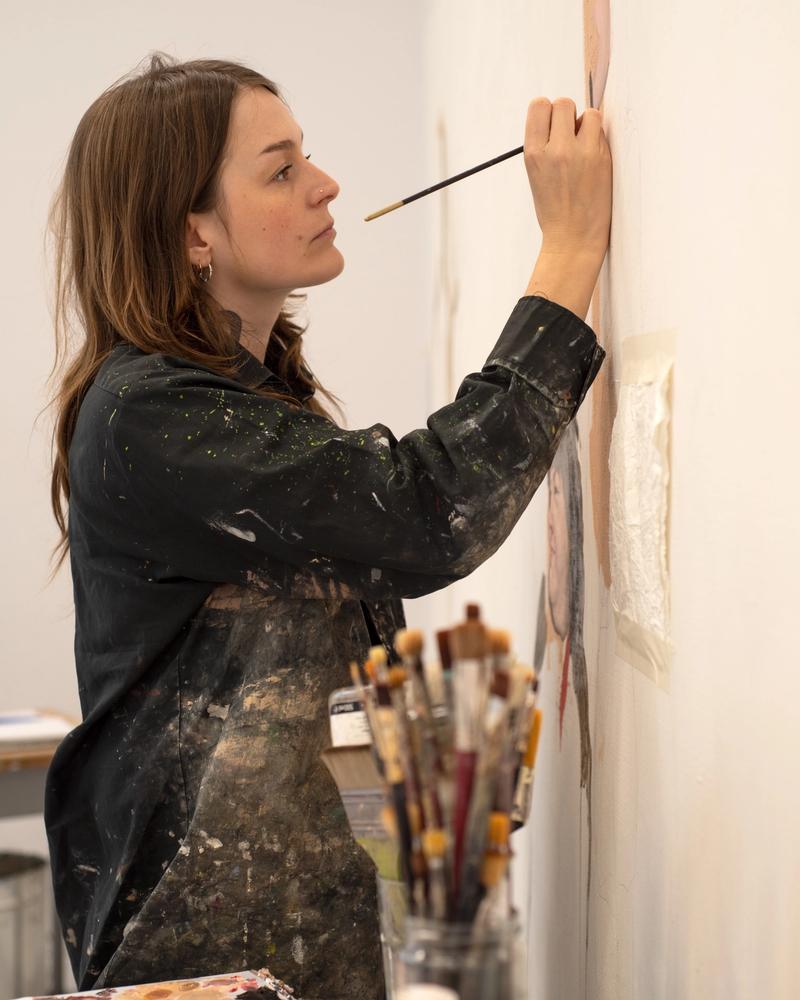Sixten Sandra Österberg
Sixten Sandra Österberg challenges established notions of traditional artistic value and perception, in painterly compositions that hover between everyday life and visual fantasy. Österberg’s paintings maneuvers through the realistic and imaginative, as well as between high art and kitsch. Seamlessly blending realistic depictions with bursts of abstract expressionism, she incorporates both classical and contemporary imagery and motifs inspired by her own social context. The artist’s use of color and technique creates images lucid as well as inscrutable and it is through this approach that she can capture visceral situations and fleeting sensations.
Österberg resides and works in Stockholm. She graduated in 2022 with an MFA from Kungliga Konsthögskolan (the Royal Institute of Art) in Stockholm and holds a BFA from Uniarts (the Helsinki Academy of Fine Arts). She has also completed an exchange year at the prestigious Akademie der bildenden Künste (the Academy of Fine Arts) in Vienna, where she shared a studio with celebrated painter Amoako Boafo (born 1984, Ghanaian visual artist).
Her solo exhibitions include (her debut solo exhibition) Förlorad form at CFHILL, Stockholm (2021); Time of Nothingness; Everything Happens at Andréhn-Schiptjenko, Stockholm (2023) and Familiar Openings at Company Gallery, New York (2024), as well as group exhibitions including Improper Walls Gallery, Vienna (2017); Accelerator, Stockholm (2020); Kunsthal Charlottenborg, Copenhagen (2020); Degree Exhibitions at the Royal Institute of Art, Stockholm (2021 and 2022); Part One, Company Gallery, New York (2023); Skin of the Soul, Magasin III – Museum for Contemporary Art, Stockholm (2023) and Gazing Bodies, CFHILL, Stockholm (2024). Österberg’s work has also been included in international art fairs like Art Basel Miami Beach, Florida, USA (2023) and Paris Internationale (2024).
Two of her recent works from 2023 (Time of Nothingness; Everything Happens, oil on canvas, 200 x 160 cm, MOM/2023/21 and Soaking Consequences 1, oil on canvas, 42 x 58.2 cm, MOM/2023/22) are in the collections of Moderna Museet (Museum of Modern Art) in Stockholm and, that same year Professor Svante Pääbo (born 1955, Swedish geneticist and Nobel laureate who specializes in the field of evolutionary genetics) chose Österberg to paint his portrait (Svante Pääbo [born 1955], PhD, Professor, Director of the Max-Planck-Institut für evolutionäre Anthropologie in Leipzig, Nobel laureate, 2023, oil on canvas, 106 x 70 cm, NMGrh 5315) for the collections of the Swedish National Portrait Gallery at Gripsholm Castle in Sweden. The gallery is the world’s oldest national portrait collection (founded in 1822 and managed by Nationalmuseum / National Gallery of Art in Stockholm), and since 1959 it has been expanded yearly with a few works, one of which is a portrait of honour – depicting a well-deserving man or woman. In 2023 the honour befell Svante Pääbo, recipient of the 2022 Nobel Prize in Physiology (or Medicine), who specifically requested Österberg to capture his likeness. In the spring of 2022 Nationalmuseum in Stockholm also asked Österberg to paint her self-portrait, which was later included, as one of the most talked-about works, in the celebrated exhibition Romantiken (26 September 2024 – 5 January 2025).
Österberg is, by no means, a stranger to Romanticism (the artistic and intellectual movement, also known as the Romantic movement or Romantic era, that originated in Europe towards the end of the 18th century) herself. Österberg’s Wanderers above a sea of fog (2024), for example, is a replica of Caspar David Friedrich’s (1774 – 1840) canonical Romantic piece Der Wanderer über dem Nebelmeer / Wanderer above the Sea of Fog (c. 1818, oil on canvas, 94.8 x 74.8 cm, Hamburger Kunsthalle, Hamburg, Germany). In Österberg’s vision, however, Friedrich’s lonesome wanderer is replaced by two black figures wearing maximally patterned skirts that trail by their combat booted and barefooted feet. They retain the same contemplative force as Friedrich’s wanderer, but perhaps with some more power. As the background seems almost to slide off the canvas, the eye comes to focus on the couple who stand in a kind of defiance.
Österberg works primarily with painting in a depicting classical tradition. 17th century easel painting, a result of hard-won craftsmanship, by masters like Rembrandt (1606 – 1669) was a powerful encounter early on and remains an important source of inspiration for her today: “That’s the reason why I’m doing it at all. Rembrandt, for example, was an early strong influence that I have lasting memories of and that made me try to recreate the depth of the picture in the same masterful way.”
Inspired by classic portraiture and the Dutch Golden Age of painting, Österberg’s works display that same technical precision and remarkable eye for detail celebrated in the œuvre of Pieter de Hooch (1629 – 1683) and Johannes Vermeer (1632 – 1675). Yet as much as she displays the formal traditions of this craft, she just as skillfully subverts early 17thcentury Dutch Golden Age, and early 19th century Romanticist, art in a production that challenges, and queers, the classical genres of art historicism. Evie Glen pointed out this fact when reviewing (‘Sixten Sandra Österberg: Familiar Openings. Queering Traditional Art History’, Metal Magazine, 2024) Österberg’s solo exhibition Familiar Openings at Company Gallery, New York, 2024:
It is a defiance, of course, against the cis-white-heteronormative and largely male dominated classical history of painting. Situating this tradition within her own contemporary work Österberg’s paintings emerge with a multiplicity of dualisms which render them faintly elusive. As they contrast the traditional and the contemporary, they similarly contrast realism and abstraction; high art and kitsch; and visceral yet entirely fleeting sensations. With the capacity for so many contrasting interpretations, every new observation of each painting becomes an entirely singular experience.
Copyright Firestorm Foundation
